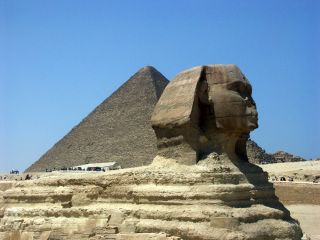The Great Sphinx

Sphinx and Great Pyramid of Khufu (Cheops)

Close Up of Sphinx, with the battered face
To me, the Sphinx was not as great as I had imagined. May be because it's smaller in size compared to the pyramids, and we couldn't get too close to it.
The Sphinx is one of the best known monuments on Earth and dates back over 4,500 years to the Old Kingdom and the time of king Khafre - builder of the second largest pyramid on the Giza plateau on Cairo's outskirts. The head of the Sphinx probably depicts Khafre, while the body is that of a recumbent lion.
The Sphinx is about 73.5 metres in length. It was originally sculptured from a limestone outcrop and, for most of its history, the Sphinx has been at least partly covered in sand. The first recorded clearing took place in the 18th Dynasty when a prince, who later became the pharaoh Thutmose IV, ordered that the sand be removed. This happened after he supposedly had a dream in which he was told that he would become pharaoh if he cleared the Sphinx.
In front of the Sphinx is its temple, while adjacent to it is the better preserved Valley Temple of Khafre. A causeway, behind the Sphinx, connected Khafre's Mortuary Temple next to his pyramid with the Valley Temple.





0 Comments:
Post a Comment
<< Home